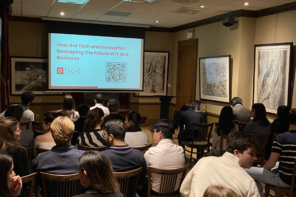5 ways to turn your apartment into an eco-friendly oasis
The ‘Go Green’ movement is a personal and global initiative, aspiring to eliminate as much waste as possible. Being eco-conscious is all about habit, but turning this habit into a lifestyle proves to be the hardest part. In that regard, Kristen Perry, member of the SSMU Environment Committee, is a model citizen. Leaving home to study at McGill was her first step towards sustainable living: “When I had to do everything by myself, I began to think more about my choices.” Nobody is going to become a sustainability expert overnight, but here are some of Kristen’s tips to get you started:
1. VERMICOMPOSTING
What is it? Using red wigglers, a special species of earthworm, to compost organic materials. These worms usually cost approximately $40 per pound, though they can be procured for a cheaper price if your town hosts a worm farming community. You can find this information online.
How to: Place worms and soil in a medium-size container. This size of the container depends on how much food you are planning on composting.
-
Place compostable waste evenly in soil
-
Add a layer of newspaper on top of the soil to retain moisture
-
If you are planning on composting highly acidic food such as citrus peels, mix it with eggshells in order to balance out the pH.
-
For quicker composting, use smaller food items. Corn cobs are going to take a while for the worms to go through, while lettuce leaves will compost much more easily.
-
Once you see that the vegetables or fruits have disappeared into the ground, just remove the now highly fertile earth and use it to start your own little rooftop garden.
2. SOLAR LAMPS
What is it? It’s simply a desk lamp that uses solar battery power.
How to: Leave it charging on your windowsill all day, and by nightfall it is ready to use.
Where do you buy one? Kristen bought hers from IKEA (SUNNAN $19.99), but solar powered lamps are available at most furniture stores.
3. DIY CANNING AND PICKLING
What is it? In the last couple of years, preserving your own fruits and vegetables has become a popular trend. It’s a great way to save money, avoid the additives and chemicals in processed foods, and eat healthy all-natural foods. Not to mention, homemade jams, jellies, and pickles are great gifts and conversation starters!
How to: Canning is a complex process that can take longer than many of the other sustainable living options. In order to get detailed instructions on how to can and preserve fruit, a quick web search on “How to can your own fruits” will yield great results. The most important requirements are a large pot of boiling water, cans, fruits or vegetables (preferably locally grown), and patience!
4. BYOU (Bring Your Own Utensils)
What is it? When eating away from home, bringing your own cutlery can save the waste created from using plastic knives and forks. Reusable pouches are convenient for doing groceries and avoiding all those plastic bags. Their size is also ideal for picking up discounted grub at grocery stores such as Segal’s (4001 Saint-Laurent, corner of Duluth) that sell bulk food. Even though this supermarket initially seems disorganized, their student-friendly prices definitely make it worth your while.
5. FREECYCLE
What is it? Free, recycled furniture. Seriously, it’s free. Avoid those over complicated, relationship-ruining IKEA manuals and remain eco-friendly by finding your furniture on freecycle.org. Instead of buying new furniture, this site puts you in contact with people who want to give away their old couches, desks, and bookshelves. All you need to do is pick it up and it’s yours to keep. Did I mention that membership is free?
___
University is the perfect time to start living sustainably. As Kristen said, we can finally make our own choices and take charge of our own initiatives. Reducing our carbon impact can start with as small an action as carrying your own cutlery. Although it takes persistence to change your Starbucks-guzzling lifestyle into an eco-friendly one, there are many green groups on campus to help you along the way. An easy way to get in contact with your green side is to attend workshops hosted by the 50 green groups around campus. McGill also offers significant sums for groups or individuals who are looking to begin their own initiatives. The Sustainability Project Fund offers $840,000 to sustainability initiatives all across campus.
To find out where to buy your own red wigglers, how to grow your own produce, or how to connect with other ecological initiatives on campus, you can subscribe to the SSMU Environment Committee listserv by sending an email to environment.ssmu@gmail.com. Start living the good, green life!











